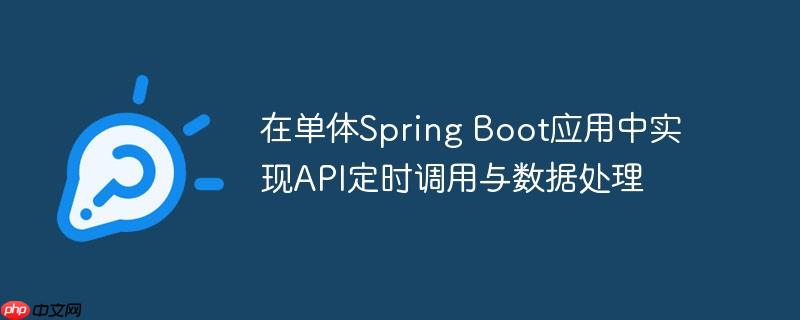
在单体应用架构中,有时需要执行以下场景:应用程序内部完成数据处理后,需要将结果通过API发送给另一个外部系统,并且这个发送动作可能不是即时的,而是基于特定条件(例如,支付完成三天后发送通知)或周期性触发。这提出了一个挑战:如何在不引入微服务的情况下,有效地管理和执行这类延迟或周期性的外部API调用任务。
解决上述问题的核心在于利用定时任务(Scheduler)机制。无论是云平台提供的调度服务,还是Spring Boot自身内置的定时任务功能,都能满足在特定时间或以特定频率触发业务逻辑的需求。
如果您的应用程序部署在云平台上(例如AWS、Azure、GCP),可以考虑利用云服务商提供的调度工具来触发您的API。这种方式将定时任务的调度管理交由云平台处理,可以减轻应用程序自身的负担,并提供更高的可靠性和可扩展性。
其他云服务商也提供类似功能,例如Azure Scheduler、Google Cloud Scheduler等。
对于不依赖特定云平台或希望在应用内部直接管理调度的场景,Spring Boot提供了强大且易于使用的内置定时任务功能。
首先,需要在您的Spring Boot主应用类或任何配置类上添加@EnableScheduling注解,以启用Spring的定时任务调度功能。
import org.springframework.boot.SpringApplication;
import org.springframework.boot.autoconfigure.SpringBootApplication;
import org.springframework.scheduling.annotation.EnableScheduling;
@SpringBootApplication
@EnableScheduling // 启用定时任务
public class MonolithicApplication {
public static void main(String[] args) {
SpringApplication.run(MonolithicApplication.class, args);
}
}@Scheduled注解用于标记一个方法,使其成为一个定时任务。该注解支持多种配置方式,其中最常用的是Cron表达式。
以下是一个具体的代码示例,演示如何使用@Scheduled来定时执行业务逻辑:
import org.springframework.scheduling.annotation.Scheduled;
import org.springframework.stereotype.Component;
import java.time.LocalDate;
import java.time.temporal.ChronoUnit;
@Component
public class OrderNotificationScheduler {
// 每天上午9点15分在亚洲/加尔各答时区执行
@Scheduled(cron = "0 15 9 ? * ?", zone = "Asia/Calcutta")
public void processDelayedNotifications() {
System.out.println("定时任务开始执行:检查待发送通知 - " + LocalDate.now());
// 1. 查询所有订单或需要处理的数据
// 假设有一个方法可以获取所有待处理的订单
// List<Order> orders = orderService.getOrdersNeedingNotification();
// 2. 遍历数据,应用业务逻辑
// 示例:检查订单支付日期是否已过去3天
LocalDate currentDate = LocalDate.now();
// 实际应用中,这里会从数据库查询订单
// for (Order order : orders) {
// LocalDate orderDate = order.getPaymentDate(); // 假设有支付日期字段
// long daysBetween = ChronoUnit.DAYS.between(orderDate, currentDate);
//
// if (daysBetween == 3) {
// // 3. 准备数据并调用外部API发送通知
// sendNotificationToExternalAPI(order);
// }
// }
// 模拟业务逻辑
System.out.println("正在处理符合条件的订单...");
// 假设这里调用了一个外部API
callExternalNotificationService("订单ID: 123, 通知内容: 支付成功3天提醒");
System.out.println("定时任务执行完毕。");
}
private void callExternalNotificationService(String notificationPayload) {
// 实际中,这里会使用 RestTemplate 或 WebClient 调用外部API
// 例如:
// restTemplate.postForObject("http://external-api.com/notify", notificationPayload, String.class);
System.out.println("调用外部通知服务,发送数据: " + notificationPayload);
}
}默认情况下,@Scheduled任务会在一个单独的线程池中执行。如果定时任务的业务逻辑耗时较长,可能会阻塞调度器,影响其他定时任务的执行。为了避免这种情况,可以将定时任务方法标记为异步执行。
import org.springframework.boot.SpringApplication;
import org.springframework.boot.autoconfigure.SpringBootApplication;
import org.springframework.scheduling.annotation.EnableAsync; // 启用异步
import org.springframework.scheduling.annotation.EnableScheduling;
@SpringBootApplication
@EnableScheduling
@EnableAsync // 启用异步任务
public class MonolithicApplication {
public static void main(String[] args) {
SpringApplication.run(MonolithicApplication.class, args);
}
}import org.springframework.scheduling.annotation.Async; // 导入Async注解
import org.springframework.scheduling.annotation.Scheduled;
import org.springframework.stereotype.Component;
import java.time.LocalDate;
import java.time.temporal.ChronoUnit;
@Component
public class OrderNotificationScheduler {
// 每天上午9点15分在亚洲/加尔各答时区执行
@Scheduled(cron = "0 15 9 ? * ?", zone = "Asia/Calcutta")
@Async // 将此方法标记为异步执行,避免阻塞调度器
public void processDelayedNotifications() {
System.out.println("定时任务开始执行(异步):检查待发送通知 - " + LocalDate.now() + " - Thread: " + Thread.currentThread().getName());
// ... (业务逻辑同上)
try {
// 模拟耗时操作
Thread.sleep(5000);
} catch (InterruptedException e) {
Thread.currentThread().interrupt();
}
callExternalNotificationService("订单ID: 456, 通知内容: 支付成功3天提醒 (异步)");
System.out.println("定时任务执行完毕(异步)。");
}
private void callExternalNotificationService(String notificationPayload) {
System.out.println("调用外部通知服务,发送数据: " + notificationPayload + " - Thread: " + Thread.currentThread().getName());
}
}通过@Async注解,processDelayedNotifications方法将在一个单独的线程中执行,而不会占用调度器的线程,从而提高了系统的并发处理能力。
在实现定时任务时,需要考虑以下关键点以确保系统的健壮性和可靠性:
幂等性 (Idempotency):
错误处理与重试机制 (Error Handling and Retries):
并发控制与分布式锁 (Concurrency Control and Distributed Locks):
可观测性 (Observability):
时区管理 (Time Zone Management):
资源消耗:
在单体Spring Boot应用中,通过合理利用@Scheduled和@Async注解,可以高效地实现对外部API的定时调用与数据处理需求。结合云服务提供的调度功能,可以进一步提升任务的可靠性和可管理性。然而,在设计和实现这类任务时,必须充分考虑幂等性、错误处理、并发控制等高级特性,以确保系统的稳定运行和数据一致性。通过遵循这些最佳实践,即使在单体架构下,也能构建出健壮且功能完善的定时任务系统。
以上就是在单体Spring Boot应用中实现API定时调用与数据处理的详细内容,更多请关注php中文网其它相关文章!

每个人都需要一台速度更快、更稳定的 PC。随着时间的推移,垃圾文件、旧注册表数据和不必要的后台进程会占用资源并降低性能。幸运的是,许多工具可以让 Windows 保持平稳运行。

Copyright 2014-2025 https://www.php.cn/ All Rights Reserved | php.cn | 湘ICP备2023035733号